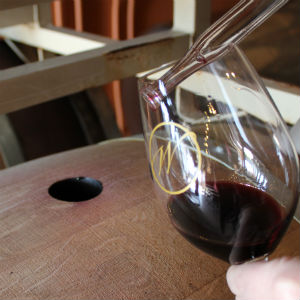Age your wine for sublime taste experiences

Age your wine for sublime taste experiences
Tuesday November 15, 2016
What happens when the wine ages?
There are a lot of interesting flavors that can only develop if you allow the wine to age. It happens both during barrel aging as well as while bottle aging the wine. To experience this we need to let the wine age. For the winemaker the planning starts early since the impact comes from the grape varietal, how it was grown, how it was made and how it was aged. As time works its magic on the wine in barrel and in bottle you will get incredibly rewarding flavor experiences. This is not for the impatient wine lover! Drinking these wines young is like eating a dish before it is ready, you get a lot of raw ingredients, but not the blended final result with all the spices added.
Fermenting with the skins, like you do with red wines, means that there are a lot of tannins in the final wine. This is why red wines age better than white wines since white wines ferment after they juice has been pressed and the skins discarded. You cannot find these flavors without taking the time to age the wine. You cannot use the microwave to create them!
Factors that influence if a wine can age
- Phenols from grapes and oak barrels
- They create new flavors as the wine matures
- They act as anti-oxidants to preserve the wine
- Higher acidity and low pH will also preserve wine
Stages that contribute to the taste
- Grapes on the vine - growing and developing flavors
- Wine in the barrel - flavors from wine and barrel combine
- Bottle aging which creates new flavors from reactions between a huge number of compounds made up of phenols, alcohol and acids.
Wine needs time to develop more flavors than what you get from the grape and from fermentation. Aging wine in oak barrels will add and enhance additional flavor in wine such as butter, cedar, spice, nuts, raisin, and vanilla. Gather your friends and do a Vertical Tasting through several vintages of the same wine and see for yourself. Here is a blog post discussing how you do that.
The most influential group of compounds for flavors in wine are the phenols. There are hundreds of phenols and one of the subgroups you hear a lot about are the tannins. Tannins are present in grapes, additional tannins are introduced by the oak barrels and they influence color, taste and the tactile sensation, the mouthfeel. They also help preserve the wine so they are much wanted for a wine that you want to keep for a long time. They do need time to soften sense the astringency you perceive when drinking a young wine.
If a big red wine like Cabernet Sauvignon tastes round and soft even though it is only 3-4 years old the winery has most likely used various enzymes to temper the mouthfeel and roundness of the wine. That wine will be drinkable faster but not show the same aging potential.

Barrel aging
Oak barrels contain another type of phenol called lignin which interacts with the tannins in the wine.
French oak barrels have twice as much tannin per surface unit as American oak – but they are 60% more expensive. They also impart different flavors since they are different species and grow in different places.
Oak barrels are more efficient as new from a flavor perspective, but may still be used as aging vessels when they have been used many times. When they have been in use many years they do not impart much flavor but still add some to the mouthfeel in that they let air work on the wine to a small degree since they are not airtight like a stainless steel tank.
We use 50% new French oak barrels for our Cabernet Sauvignon since we want to get the tannins from the oak to interact with the tannins and other substances in the wine.
The toasting of the barrel is an important component as it drives flavors of vanilla, honey, burned caramel and more. How and where the oak trees grow will also differentiate the taste influence of the barrel. We take our barrels form three different coopers to get even more complexity to the wine.
Tannins in both wine and barrel add to the aging potential and flavor profile and gives our wine an ability to mature a long time, often decades.
Bottle aging
Reactions between all the compounds in wine create new interesting flavors while it is aging in the bottle. As the fruity aromas of the young wine dissipates there will be mature flavors evolving. Complex compounds stemming from phenols, alcohol and acids create new flavors as they combine in the bottle. The tannins keep creating longer and more complex molecules that are softer on our tongue.
Some aromas and tastes you can find in Cabernet Sauvignon are blackberry, cherry, sour cherry, blackcurrant, licorice, anise, violet, earth, coffee, tobacco, leather, vanilla, hazelnut, almond, butterscotch, herbs, eucalyptus, bay leaves, green bell pepper, grass. Some aromas are more obvious when you first smell the wine, some will come to you when you taste the wine the first time, some at the tip of your tongue, some in the back and some once you have swirled it in your mouth a while. You will also find new flavors as the wine warms in the glass and you taste a second time. This is because there are flighty compounds that hit your nose at first but then disappear in favor of the slower ones.
You can find aromas of sweaty horses and stable which have long been the hallmarks of French old Bordeaux, which is why some wine lovers will pay enormous amounts for bottles that have been aged a long time. There is something for everyone in the world of wines. You could not find these flavors without the time component. You cannot use the microwave to create them!


